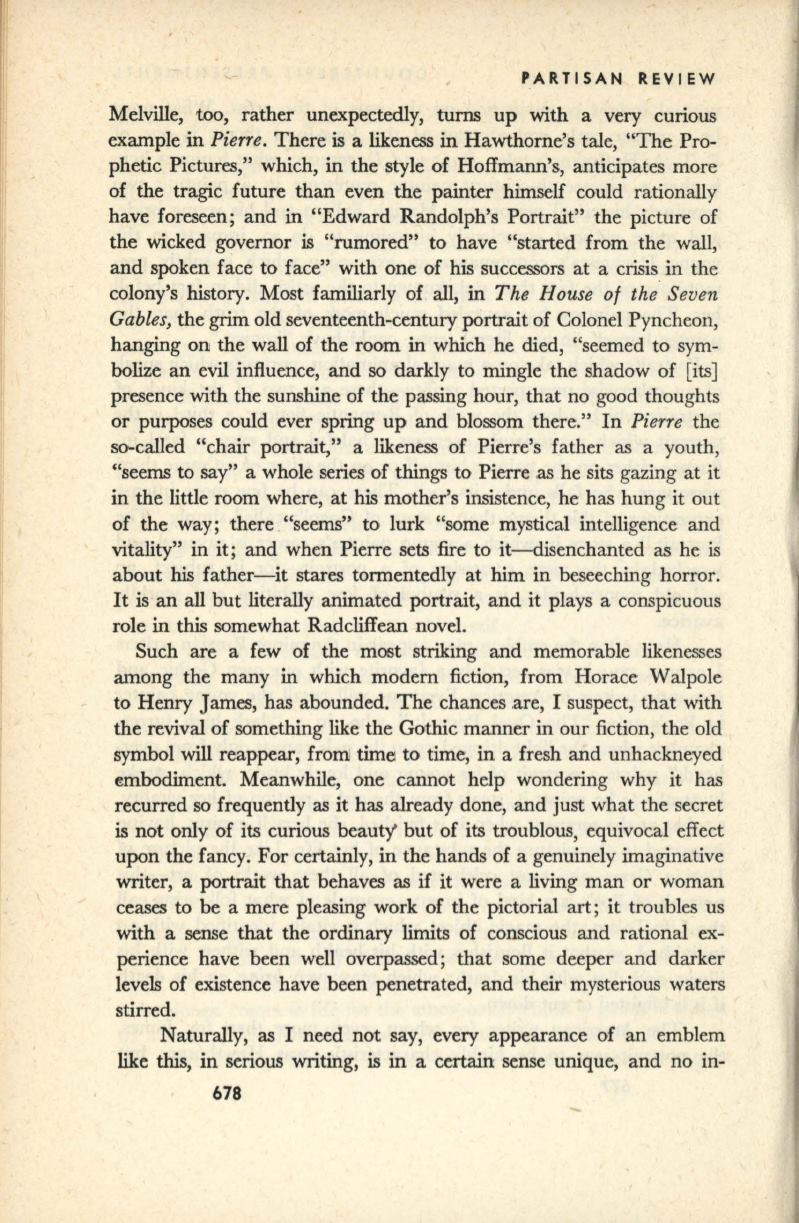
PARTISAN REVIEW
Melville, too, rather unexpectedly, turns up with a very curious
example in
Pierre.
There is a likeness in Hawthorne's tale, "The Pro–
phetic Pictures," which, in the style of Hoffmann's, anticipates more
of the tragic future than even the painter himself could rationally
have foreseen; and in "Edward Randolph's Portrait" the picture of
the wicked governor is "rumored" to have "started from the wall,
and spoken face to face" with one of his successors at a crisis in the
colony's history. Most familiarly of all, in
The House of the Seven
Gables,
the
grim
old seventeenth-century portrait of Colonel Pyncheon,
hanging on the wall of the room in which he died, "seemed to sym–
bolize an evil influence, and so darkly to mingle the shadow of [its]
presence with the sunshine of the passing hour, that no good thoughts
or purposes could ever spring up and blossom there." In
Pierre
the
so-called "chair portrait," a likeness of Pierre's father as a youth,
"seems to say" a whole series of things to Pierre as he sits gazing at it
in the little room where, at his mother's insistence, he has hung it out
of the way; there ."seems" to lurk "some mystical intelligence and
vitality" in it; and when Pierre sets fire to it-disenchanted as he is
about his father-it stares tormentedly at him in beseeching horror.
It is an all but literally animated portrait, and
it
plays a conspicuous
role in this somewhat Radcliffean novel.
Such are a few of the most striking and memorable likenesses
among the many in which modern fiction, from Horace Walpole
to Henry James, has abounded. The chances are, I suspect, that with
the revival of something like the Gothic manner in our fiction, the old
symbol will reappear, from time to time, in a fresh and unhackneyed
~mbodiment.
Meanwhile, one cannot help wondering why it has
recurred so frequently as it has already done, and just what the secret
is not only of its curious beauty' but of its troublous, equivocal effect
upon the fancy. For certainly, in the hands of a genuinely imaginative
writer, a portrait that behaves as if it were a living man or woman
ceases to
be
a mere pleasing work of the pictorial art;
it
troubles us
with a sense that the ordinary limits of conscious and rational ex–
perience have been well overpassed; that some deeper and darker
levels of existence have been penetrated, and their mysterious waters
stirred.
Naturally, as I need not say, every appearance of an emblem
like
this,
in serious writing, is in a certain sense unique, and no in-
678


